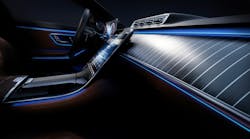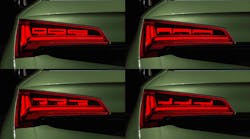Unlike incandescent bulbs, halogen lamps or LEDs, which are all point sources, OLEDs are flat area sources; they emit light uniformly from everywhere on their surface. This means that diffuse, glare-free lighting effects can be created without the need for special screens, mirrors or reflective ribs such as those used to diffuse the light from fluorescent tubes. And, if the industry goals are realized, these new lights should eventually far surpass many current lighting technologies in energy efficiency, lifetime and color rendering.
Eventually, the OLED industry hopes that this new lighting technology could compete with the fluorescent tubes and incandescent lamps that currently light up offices and homes and complement point source technologies such as LEDs. Before these mass-market applications occur, OLEDs could find their way into any number of smaller and more specialist lighting applications such as illuminated signs. Of course, OLEDs have already penetrated the small display market and are commonly seen in MP3 players and in secondary displays in mobile phones handsets.
+++++++
This article was published in the February 2007 issue of LEDs Magazine.
To read the rest of this article, please visit our Magazine page, where you can download FREE electronic PDF versions of all issues of LEDs Magazine.
You can also request a print copy of LEDs Magazine (available by paid subscription).






